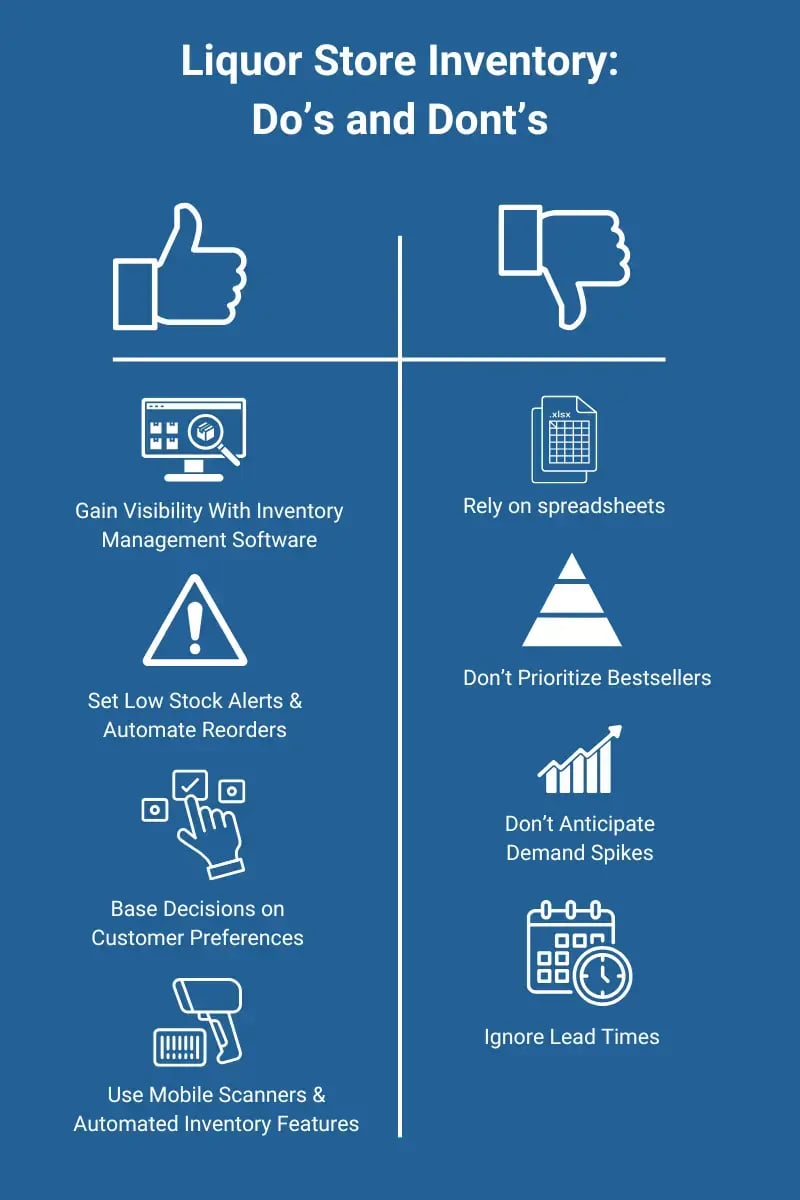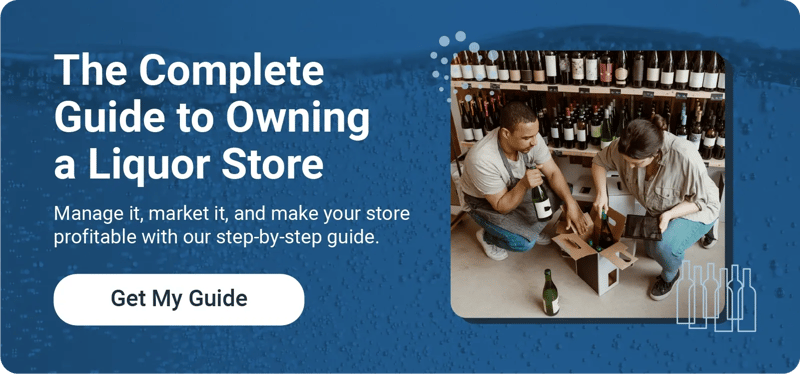They say you can't teach an old dog new tricks. In our experience, it’s simply not true.
Liquor store inventory management that’s done on spreadsheets or old software may have gotten you to where you are, but it also stops small liquor stores from reaching their full potential.
By embracing the latest inventory management best practices and the systems on your point of sale (POS) software, you can free up time to spend on customer service and marketing.
When it comes to inventory management, you can always teach an old dog a few new tricks.
In this article, we’ll explain why updating your inventory management system is worth the investment and provide eight liquor store inventory management do’s and don’ts.

Why Investing in Liquor Store Inventory Management Matters
Optimizing inventory levels in a liquor store is essential because it’s the primary way to reduce overhead costs, increase sales, and keep customers happy.
Managing hundreds if not thousands of products can quickly become a massive headache without organization and structure.
Keeping a close eye on inventory levels, determining when stock is low, and deciding what to order are all critical processes for a liquor store. They are also some of the most time-consuming processes.
Luckily, modern liquor store POS systems have made inventory management significantly easier. From reducing data entry and stockouts to automating receiving and spotting bestsellers, inventory management software makes it much easier for small liquor stores to improve the customer experience and stay competitive.
Some of the major benefits of liquor store inventory management software include:
- Better visibility: See updated stock levels every time you make a sale and track cases of wine or beer by bottle, six-pack, or can.
- Easier data entry: Update liquor inventory using thousands of SKUs or add custom products for promotional bundles.
- Streamlined reorders: Centralize all your supplier information in one system and set low stock alerts so you’re never caught off guard by a sudden stockout.
- Discover trends: Use your existing data in reports to identify bestsellers, financial performance, shrinkage sources, and more.
- Faster counts and audits: Barcode scanners and other streamlined counting processes help you quickly perform regular inventory audits.
The good news is, that these advanced features don’t come at the expense of a large learning curve. Most systems are easy to learn and use, meaning your daily workload will likely be far less complex after adopting inventory management software.

4 Key Liquor Store Inventory Management Don’ts
If you’re trying to modernize your inventory process, try and avoid these common mistakes.
1. Rely on Stock Spreadsheets
Inventory management might be a newer term, but the concept is nothing new. Counting inventory avoids discrepancies and ensures your store is sufficiently stocked so customers can get the exact products they’re after.
The average size of liquor store stock is in the thousands, making manual inventory tracking time-consuming and error-prone. In a worst-case scenario, it’s also extremely easy to miss cases of employee theft.
You have to manually count and document when inventory is received and then count when stock is sold. Your team must then investigate any discrepancy between the two.
Staying on top of that documentation can take you away from your customers and from tasks or actions that drive store growth.
2. Don’t Prioritize Bestsellers
Off the top of your head, do you know which brands of whiskey are most popular? How about customers’ favorite red wine — or, even more specifically, their favorite Merlot?
While you probably know which of your products are overperformers, many liquor store owners don’t fully understand their bestselling products.
This isn’t surprising. Despite stocking a little bit of everything, store owners all have personal preferences and naturally keep an eye on those items more than others. However, manual inventory processes might mean you’re chronically understocking certain products without realizing it.
The result? More frequent stockouts of popular items or a growing amount of bottles gathering dust in storage.
Related Read: 5 Liquor Industry Trends: Set Your Store Up For Success in 2024
3. Not Anticipating Demand
Sometimes, there are unexpected surges in demand that are nearly impossible to prepare for. But many times, “unexpected” translates to a lack of visibility.
It's nearly impossible to spot trends without access to historical sales data. These trends can be invaluable for keeping things in stock and determining when to hire more staff.
Here’s an easy example.
Imagine you run a store in a college town. During football season, beer sales increase significantly over the weekends (specifically by 15% overall, with a few brands outperforming others). You can then start to prepare by timing orders to have extra beer in stock by Friday mornings, especially for those overperforming brands.
This practice is called demand forecasting. It uses your sales data in coordination with outside factors (e.g., times of the day/week, seasons, events, weather, holidays, etc.) to spot common trends.
If you don't pay attention to demand forecasting, you could be understocked during big events, resulting in a lot of lost money. Conversely, following a hunch could mean that you might be adequately stocking some items and overstocking others.
4. Ignoring Lead Times
When it comes time to reorder, many liquor store owners forget about lead times. Every supplier moves at a slightly different speed, and understanding their unique lead times is key to optimizing inventory.
For example, you might have a local (and unusually quick) connection for craft beer. Because of that, you can wait a little longer before sending in that purchase order. But maybe your liquor supplier takes a day or two to even get moving.
You need a system for tracking the various levels at which different products need to be reordered. This is another area where a lack of visibility, as opposed to a lack of experience, is the primary challenge.
4 Liquor Store Inventory Management Do’s
Whether you’re starting a liquor store or have been in business for years, it’s never too late to adopt these inventory best practices.
1. Gain Visibility With Inventory Management Software
The hardest part of managing inventory is not knowing where stock levels are at any given time. Following any of the other best practices on this list is impossible without an accurate, real-time view of stock levels.
While we may be biased, our top recommendation for improving inventory is adopting inventory management software in your store.
Put simply, inventory management software keeps a running tally of your stock and automatically updates stock numbers when sales are made. This simple improvement unlocks many opportunities to improve not just inventory processes but also your business decisions.

2. Set Low Stock Alerts and Automate Reorders
Once you have an inventory management system, you can streamline your daily tasks, including purchase orders.
Set low stock alerts for items based on supplier lead times. This will alert you the minute stock falls below a certain threshold so you can set up a reorder. Streamlined vendor management will also keep vendor information at your fingertips to speed up purchase orders.
Some systems, including Bottle POS, support automated reordering and reorder calculations. This feature uses historical sales data to calculate how many units to reorder for a given time period (e.g., a 30-day supply) and automatically sends purchase orders for that amount.
3. Base Purchase Decisions on Customer Preferences
Prioritizing the customer is the first rule of effective customer service. The same is true of inventory management.
Knowing which products are bestsellers will help you avoid stockouts, organize your store, and buy similar items. These insights are essential to meeting customer demand and keeping your selection fresh.
Use the reports on your POS system to find your most popular items and make smarter decisions about future ordering, pricing, and promotional campaigns. You might even find a few surprises.
For example, you might notice that an expensive scotch sells shockingly well relative to its high price point. You look at similar items only to find you don’t have many cheaper alternatives. That could indicate that expanding your mid-range scotch collection will be popular with customers.
Systems that include auto ranking make these decisions even easier. Auto ranking takes your products and assigns them a ranking and color to see your bestsellers and least popular items at a glance.
4. Use Mobile Scanners, Automated Invoicing, and Case Break Inventory
Manual data entry is the bane of productivity — yet, it’s something that many liquor store staff have to do every day.
Streamline your restocking process by using these functions.
- Automatic invoicing: Import the entirety of a purchase order based on the invoice instead of entering new items one at a time.
- Case break inventory: Enter items into inventory based on how you plan to sell them. For example, if you order a box of beer and plan to sell it individually as part of a “make your own six pack,” you can track each can instead of the whole case.
- Mobile scanners: Speed up inventory counts and receiving by using mobile scanners. Some systems even allow you to scan barcodes using the camera on your phone or tablet.
Important note: Not all of these functions are available in general retail point of sale systems. That’s why we always recommend using a liquor store POS system to get the most bang for your buck.
Bottle POS Makes Liquor Store Inventory Management Easier Than Ever
Eliminating errors and reducing the time spent on manual inventory management are crucial to the success of any business — especially liquor stores that carry thousands of unique items.
Old and manual processes are focused simply on completing a specific task, whereas modern technology can help you prepare for future success.
Point of sale solutions like Bottle POS provide business owners with a detailed and easy-to-manage overview of their business and its operations. This saves time, helps them make better decisions, and keeps customers happy.
Talk to our liquor store experts today to see how Bottle POS can take your liquor store to the next level.













